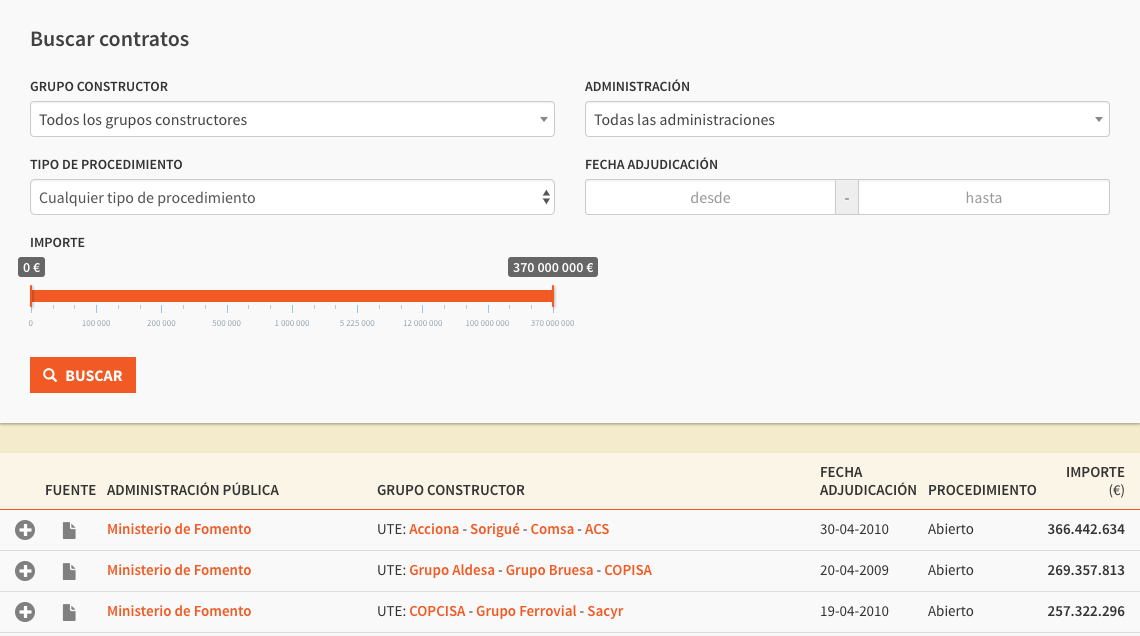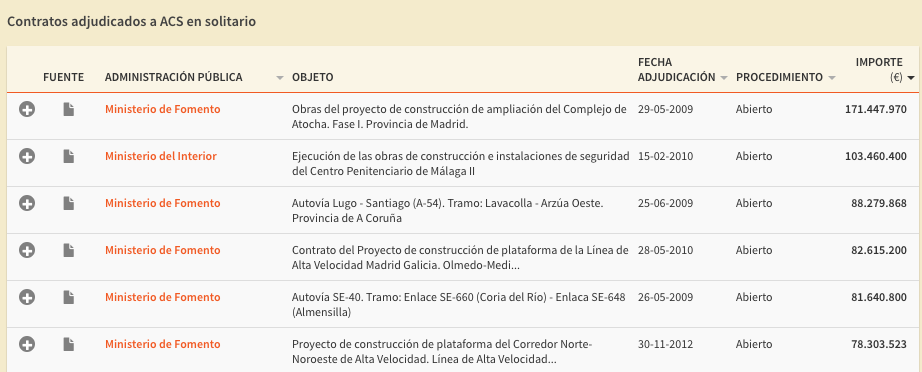Who Is Paid For The Job? Search all public works contracts published in the Spanish Official Gazette since 2009
A journalistic investigation of Fundación Civio analyses and allows access to 8,052 contracts awarded in the last seven years, for a total value of 38,828 million.
- A journalistic investigation of Fundación Civio analyses and allows access to 8,052 contracts awarded in the last seven years, for a total value of 38,828 million.
- Who Is Paid For The Job? analyses who have been the largest beneficiaries, their relations, what happened with the great civil works and carries out an analysis of the public works in Spain.
- The ACS group leads the ranking: it is present in one out of ten contracts investigated.
Civio, a non-for-profit organisation that promotes the transparency and the accountability of the institutions through technology and journalism, presents today Who Is Paid For The Job?, an investigation that shows and analyses for the first time all public works contracts published in the Official Gazette between 2009 and 2015. In our web Who Is Paid For The Job?, anyone can access detailed information of 8,058 contracts, which total 38,828 million euros.

Civio, which earned the Gabriel García Márquez 2016 Journalism Award for investigating the global gap in access to essential medicines, launches this initiative to bring some light and transparency to the public works procurement, main point in several judicial cases opened because of irregularities associated to corruption in urban politics and illegal party funding.
In Who Is Paid For The Job? any user can easily access individual factsheets of 2,489 construction groups, including 2,664 companies. Each file shows which administrations have awarded companies the largest contracts, the procedure used and the temporal evolution of the works. There is also a breakdown of contracts directly awarded and those obtained through Temporary Consortiums (UTE) in which they participate. With regard to the contracting authority, the 312 public administration factsheets show both, the contracts they have awarded and the construction groups most benefited by them through the official gazette.

Who are the Kings of the brick?
More than 2,600 companies have been awarded public works contracts published in the official gazette between 2009 and 2015, but the data extracted and analysed by Civio reveal that the ten large Spanish construction groups have been present in seven of every ten euros of works awarded since 2009. Or, in other words, in 23,871 million of the total of 38,828 million awarded.

As Who Is Paid For The Job? reveals, the ACS group leads both the classifications, running alone and running in the temporary consortiums. ACS is present in one of every ten contracts analysed in the last seven years. ACS main contractors are the Ministry of Public Works, the City of Madrid and the Community of Madrid. “In the seven years analysed, only in two of them were overtaken by their competitors in obtaining public contracts,” explains Eva Belmonte, project manager of Civio. “In 2012 by Ferrovial, thanks, in large part, to the award of several sections of the AVE (High Speed Train) to Galicia; and in 2011 by Acciona, awarded the construction of the new hospital in Teruel and the fish market of the port of Ribeira in A Coruña”. Among the bidding administrations, the Basque Country is the autonomous community that has awarded a greater volume of money in public works contracts in this period among those published in the official gazette. Among local administrations, the City Council of Madrid stands out.

A in-depth analysis of public works
Civio’s research reveals that since 2009, when public administrations distributed 14,000 million through 2,407 job awards via official gazette, figures have declined year by year (9,563 millions awarded in 2010, 4,685 in 2011, 3,202 in 2012), up to reaching its lowest figure in 2013 (with 1,326 million euros in contracts). In spite of the increase data show since then, the great figures of the golden age of public works have never been reached again.
The contracts analysed between 2009 and 2015 range from 4,306 euros to more than 336 million euros, the award price of the works of La Sagrera AVE (high speed train) station in Barcelona. In fact, of the 30 largest works, 18 have been allocated to high speed, taking into account stations, platforms, tracks and other railway infrastructures.
The opacity of the corporate percentage in the UTE
Of the total amount awarded, 40.8% was taken by companies running alone and 59.2% went to Temporary Consortiums (UTE). The importance of these structures, with greater levels of opacity than those of any other company, is evident in large public works. In fact, of the 2489 business groups analysed, only 1327 run always alone. Other 1162 business groups are in some UTE and 641 only appear that way, never come up alone. “Although the data of the establishment of any other type of company are public in the Business Registry, those of the UTE, new companies that are created expressly to contract with the administration, remain under the lock of the administration,” explains Eva Belmonte. Just before publishing the project, the Transparency Council dismissed the appeal filed by Civio to determine the corporate percentage within each UTE.
A citizens’ initiative that represents a step towards transparency
“Users will find in Who Is Paid For The Job? an in-depth research on public works awarded through the official gazette in the last seven years, accompanied by a large database and a first approach of Civio to the field of public procurement, with articles and learning materials”, explains Belmonte. “All these data and the learning obtained will allow us to open new lines to work for a more transparent public procurement and to make new researches we will publish in the coming months,” adds Civio’s project manager.